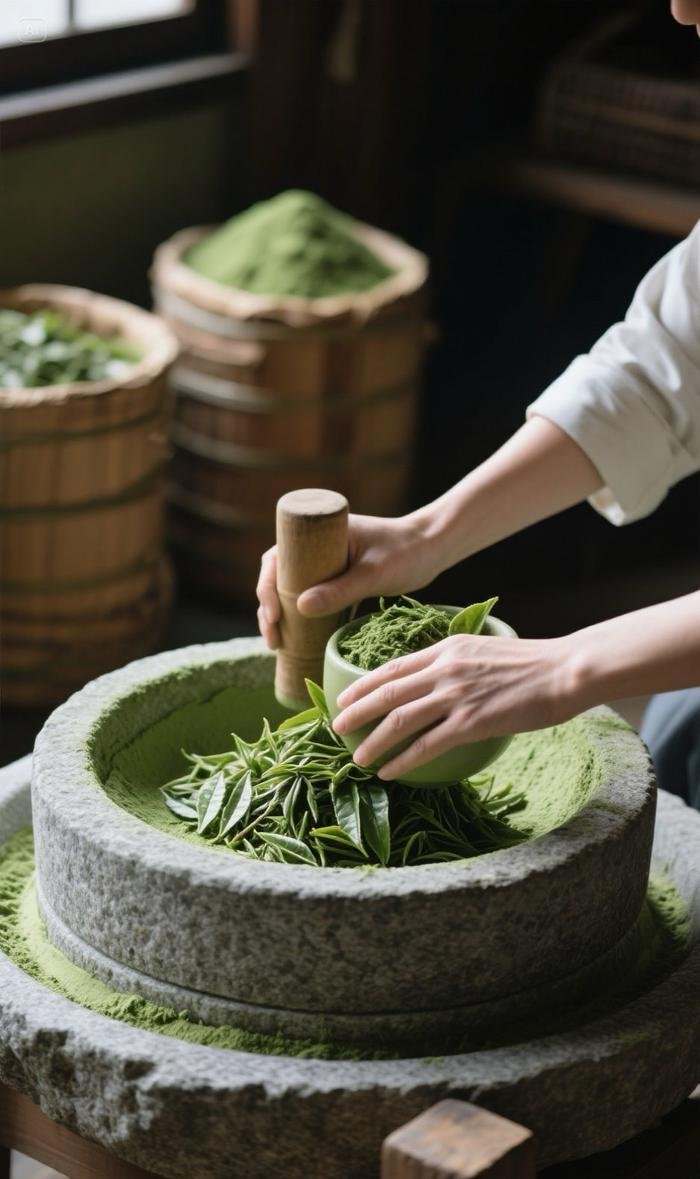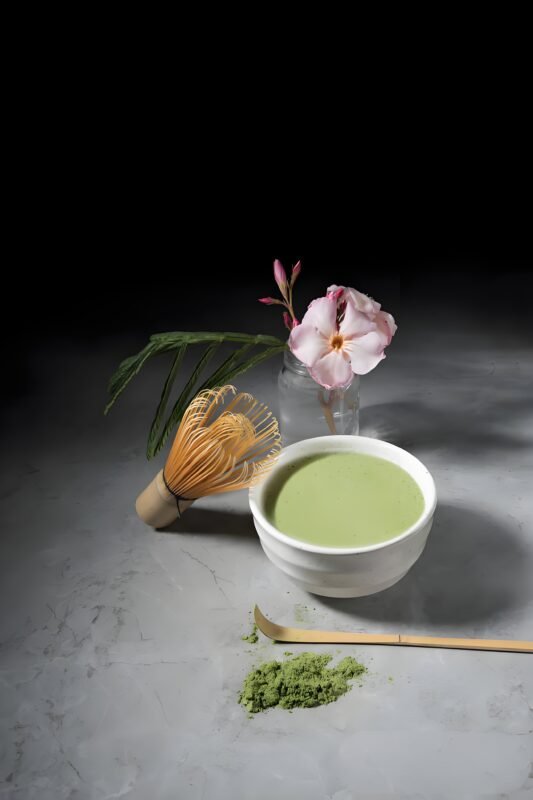How to Make Green Tea with Matcha? 90% Get It Wrong! This Method Makes Every Sip Amazing

How to Make Green Tea with Matcha?
Struggling to brew perfect green tea with matcha? Discover why your tea turns bitter and how to master the technique for vibrant, aromatic results. Uncover the secret to blending matcha and green tea like a pro—no more harsh flavors, just pure tea perfection.

“Wait, can you really make green tea with matcha?”
“I tried adding matcha powder to green tea for ‘double tea aroma,’ but it tasted bitter and astringent. What went wrong?”
If this sounds familiar, you’re not alone. As the owner of a 200-year-old tea garden, let me clarify: Matcha and green tea are “twin flowers of tea,” sharing the same roots but needing a specific approach. Here’s how to “activate” green tea with matcha like a pro—and why China’s century-old wild tree matcha is the soul of this brew.
一、3 Core Principles to Master When Making Green Tea with Matcha
Many treat matcha as a “flavoring powder,” tossing it into green tea randomly. The truth lies in three key factors: tea characteristics, processing differences, and water temperature control.
1. What’s the relationship between matcha and green tea?
Matcha is a deep-processed version of green tea: fresh leaves are steamed, dried, and ground into ultra-fine powder (particle size <5 microns), retaining all nutrients (polyphenols, amino acids, chlorophyll) but with 3-5x higher concentration than regular green tea.
Simply put: Matcha is concentrated green tea powder. Brewing it with green tea is about blending high-concentration powder with low-concentration tea soup.
2. The “3 Warmth, 3 Pause” method: Your step-by-step guide
This tried-and-tested formula works for beginners:
Step | Details | Principle |
Warm the cup | Rinse utensils ( gaiwan / glass) with 85℃ hot water to maintain temperature. | High heat locks in aroma, crucial for matcha’s grassy notes. |
Add tea | Use matcha:green tea = 1:3 (e.g., 1g matcha + 3g green tea). Place green tea first, then sprinkle matcha (to avoid clumping). | Green tea balances matcha’s intensity for a smoother taste. |
First pour | 80℃ water, spiral-pour 1/3 of the cup. Let sit 30 seconds (dissolve matcha, 舒展 green tea leaves). | Low temperature reduces bitterness from caffeine and polyphenols. |
Second pour | 85℃ water, fill to 2/3. Gently shake the cup (awaken matcha aroma, blend with green tea’s freshness). | Medium temperature releases matcha’s seaweed scent and green tea’s bean aroma. |
Third pour | 90℃ water, fill to the brim. Let sit 1 minute (allow full fusion, cool to drinking temperature). | High temperature enhances freshness, maintaining layers as it cools. |
3. Pitfalls: 2 types of water to avoid at all costs
❌ Tap water: Chlorine destroys matcha’s freshness, leaving a “bleach-like” taste.
❌ Boiling water: High heat turns matcha’s grassy notes bitter and over-steeps green tea.
二、Why Chinese Matcha Outshines Japanese Matcha: The Secret of Century-Old Trees
Many think “Japanese matcha = premium,” but connoisseurs know China’s wild, century-old tree matcha from Yunnan and Guizhou is the underrated gem.
1. Ingredients: The 先天 advantage of century-old wild trees
While Japanese matcha uses shaded tea plants (30-day cover to boost amino acids), China’s Yunnan wild 古树茶 offers:
• Grown in primeval forests: Tea trees in Ailao Mountain and Wuliang Mountain coexist with trees, thriving on natural humus—no fertilizers or pesticides.
• Over 100 years old: Older roots (reaching 3m deep) absorb 2-3x more minerals (potassium, magnesium, zinc) than ordinary tea.
• Wilder nutrients: Tests show century-old tree matcha has 15% more polyphenols and 20% more amino acids than Japanese matcha (2023 South China Agricultural University report).
In short: Japanese matcha is a “greenhouse flower,” while Chinese 古树 matcha is a “mountain warrior”—richer, more layered, and less one-note.
2. Craftsmanship: The “artisan spirit” of intangible heritage stone milling
Japanese matcha uses machine grinding (high efficiency, but high heat damages aroma). Chinese 古树 matcha insists on:
• Stone mill grinding (15 rotations/minute): Low heat preserves grassy and seaweed notes.
• Yunnan marble stones: No metal contamination, purer powder (particle size <3 microns, dissolves easily).
• 8-10 grinding passes: Finer texture for smoother brewing.
A longtime customer said: “Japanese matcha tastes flat, but yours has a wild mountain essence—after drinking, my throat feels incredibly smooth!”
3. Culture: A thousand-year legacy from “tribute tea” to lifestyle art
Chinese matcha dates to the Tang Dynasty—”mo cha” (powdered tea) in Lu Yu’s The Classic of Tea. It thrived in Song Dynasty dian cha (whipped tea) and Ming-Qing tea banquets.
Japanese matcha arrived in the 12th century from China. While it developed “wabi-sabi” culture, the core traits of “freshness, richness, and smoothness” shine brightest in Chinese 古树 matcha.
三、Brew with Century-Old Tree Matcha: Taste the “Mountain Breeze”
Last week, I demonstrated the method with our 200-year-old wild tree matcha and spring-harvested green tea (1g matcha + 3g green tea, following “3 Warmth, 3 Pause”):
·第一泡 (First brew): Light green, 透亮 tea soup. Flavor: grassy notes with subtle honey sweetness—like biting into fresh bamboo leaves.
·第二泡 (Second brew): Richer aroma—roasted chestnut scent mixed with wild orchid sweetness, warming the throat.
·第三泡 (Third brew): Thick, creamy texture like melted matcha ice cream. 回甘 (Sweet aftertaste) lingered on the tongue for 30+ minutes.
A tea friend exclaimed: “So Chinese matcha brewed with green tea tastes like mountain wind in a cup!”
Conclusion: Tea is about rooted authenticity
Brewing green tea with matcha isn’t a gimmick—it’s about reviving traditional tea charm with modern technique. The key? Quality tea. China’s century-old wild tree matcha, nurtured by a century of sun, rain, and soil, offers deeper, more layered mountain flavors.
Next time someone asks, “Is it right to make green tea with matcha?” Answer confidently: “Yes— but only with China’s century-old tree matcha!”
Comment below: Have you tried making green tea with matcha? What’s the most amazing matcha flavor you’ve tasted? The top 5 liked comments get a free sample pack of our century-old tree matcha (includes matcha powder, wild green tea, and brewing guide)!

